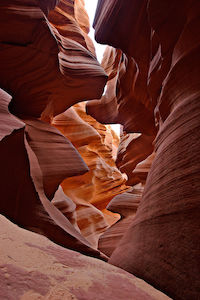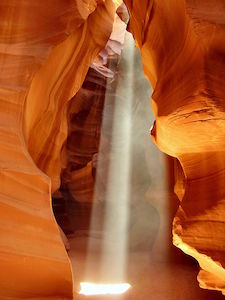 The Grand Canyon in the U.S. is what the name says; it’s grand – big and impressive. Anyone who stands at the rim (outside edge) and looks into and across the canyon sees something unlike anything they have ever seen before. If you do a Google search using “Grand Canyon” and “adjectives”, most of the adjectives you find describe reactions to the canyon, but don’t say much about the canyon itself. It is, in many ways, indescribable (impossible to describe).
The Grand Canyon in the U.S. is what the name says; it’s grand – big and impressive. Anyone who stands at the rim (outside edge) and looks into and across the canyon sees something unlike anything they have ever seen before. If you do a Google search using “Grand Canyon” and “adjectives”, most of the adjectives you find describe reactions to the canyon, but don’t say much about the canyon itself. It is, in many ways, indescribable (impossible to describe).
Like many canyons around the word, the Grand Canyon was created by the action of a river, the Colorado, which for millions of years has been cutting through layers of rock to create a channel (space for water to flow through) that grows deeper and wider every year.
Antelope Canyon, about one hour away from the Grand Canyon, is a very different kind of canyon.
If someone were to take you blindfolded (with a cloth covering your eyes) to Antelope Canyon, place you at the bottom, and then take off the blindfold, you would first be struck by (strongly notice) the tightness (very little room to move) of the space. In many places the canyon walls are so close that you can reach out and touch both of them at the same time.
The canyon walls, decorated with narrow lines of color, move in and out from bottom to top, like waves. And as you look ahead, the canyon walls twist and turn into the distance, and you can often see only a few feet in front of you.
 The movement of light on the canyon walls creates a constantly changing pattern of reds, oranges, yellows – dark one moment, uncomfortably bright the next – and shadows as the sun moves across the sky. When the sun is directly overhead, it often cuts through the narrow space to shine like a spotlight on the canyon floor, as in the photo.
The movement of light on the canyon walls creates a constantly changing pattern of reds, oranges, yellows – dark one moment, uncomfortably bright the next – and shadows as the sun moves across the sky. When the sun is directly overhead, it often cuts through the narrow space to shine like a spotlight on the canyon floor, as in the photo.
Antelope Canyon, a slot (long narrow opening) canyon, is much deeper than it is wide. A slot canyon may be only 3 feet (1 meter) wide at the top, but more than 100 feet (33 meters) deep. They are created by underground water cutting through soft rock, like sandstone or limestone.
Slot canyons can be found in many parts of the world. Those in the southwestern U.S. – more than 1,000 – are probably the best known, but other other well-known slot canyons can be found in northern Spain, in the Pyrenees Mountains between France and Spain, and in the Blue Mountains west of Sydney, Australia.
Maligne Canyon, in Jasper National Park in Alberta, Canada, is a particularly interesting slot canyon. Much of the water that runs through the canyon comes in a unusual way from Medicine Lake 8.5 miles (14 km) away. One guide compares the lake to a leaky bathtub – water leaks (runs out through holes or cracks) out of the bottom of the lake and runs underground to the canyon.
For all of their fascinating features (characteristics), slot canyons can be dangerous to visit. Once you are in a slot canyon, it can be difficult and take time to get out. Rainstorms, even if they are some distance away, can cause flash floods (sudden local floods) to rush through the canyons. As a result, many canyons, like Antelope, require visitors to have trained guides to take them through the canyons.
If you are interested in learning more about slot canyons, look at the Los Angeles Times article – A Hiker’s Sampler of the Southwest’s Slot Canyons.
~ Warren Ediger – ESL coach/tutor and creator of the Successful English website.
Photos of Antelope Canyon and Lower Antelope Canyon are from Wikipedia Commons.
Very nice article. I´m always learning from you guys.
Cheers!!!
Hello.
Reading the piece I couldn’t help but thinking about this…how can I say that…kind of duality that characterize our entire existence.
By that I mean that on one hand we can marvel at those stunning beautiful places.
On the other hand, often time those same places we are attracted to, are very dangerous and deadly.
I can give you many examples..like going: underwater, hiking, outer space….
and so on, you get the idea.
Who knows? Maybe, at times, being aware of the risks is what makes the experience more enjoyable.
I was thinking that most women, under certain perspectives have that same characteristic….like..they possess pulling power but …..at times, are very dangerous and you get hurt.
Thanks.
Well
True
Slot Canyons are beautiful
But they are as dangerous
With the narrow passage at a long slit-like long opening on the ground that in come area is 3 meter it more deep
Man
I bet there are a lot of snakes burrowing lairs at the foot of the slot cantons walls.
It is the best environment for them
If is a way from the scolding sun abd secluded enough.
However ,what happens when there is some rain fall
U know
The slots narrows as they go deeper
So ,even a bit of rain can flood the damn thing
So what said snakes do in case of flooding
However , as beautiful as they seem I never risk it.
U know
I heard it tell a few people died attending the bottom of slot canyons around the world.
Well , rumour has it that the most infamouse canyons located in US.
So if u happen to travel down there don’t forget to pack a cano in case of rain or shower :))
Well
The talk is in some areas they get so narrowed that u need to walk through the passage sideways.
U know
I ,for one , prefer to watch a footage of the area that brave it
Yup!!!
I m not much of a daredevil
And as I’m getting older , the sofabed in my living in front of the TV becoming more and more appealing to me.
A learning guide member
🙂
Pete
Hello.
Those places are fascinating geological features.
Where I live, the most impressive geological feature is observing what the African tectonic plate created pushing towards north against the European one.
Driving home, right on the side of the road, I always marvel at those impressive rocks clearly pushed vertically and curved like it was melted plastic.
Thanks
Living in a big city like Madrid you may imagine that I am fascinated by these so incredible
sites that nature make.
When I go out home it is all so ugly, dirty and not natural that sometime i remain inside
for long.
Dan, now I am like you living alone with the company of my dear Gatufo.
Finally Cuca has gone to a nursing home because being here it seems nearly quite difficult
and doctors said long ago it is better for her, even for me, to be there.
I am not so sure, but evidently every week or day she was going worst and it was not
convenient and really very sad.
That´s all, new sad life for both of us but such is life, we can do nothing about illness
or these kind of events.
emiliano
Dear and well admired Warren,
There must be a diversity of canyons out there, musn´t it be? and this one of Colorado even being beautiful and huge has no much to do with the one I visited once, and that you are referring to in your post as to be located between France and Spain just in the middle of western Pyrinees.
The Gorges of Kakuetta or Kakueta Canyon in parallel with the toponim applied to the Big Canyon of Colorado, this one could be called Evergreen Canyon or Siempreverde Canyon, or Greenish Canyon. Green forests and pure torrential water are the main features, rest is nature´s work.
In Spanish, Colorado means reddish or simply the color red, so it´s quite obvious.
The French word “gorge” applies to the English word canyon in this orographic context, even the literal meaning is throat of an animal or human. It´s maybe because in this case the slot on the ground is quite narrow that gives the impression in the depths of walking inside the big throat of a giant animal, kilometers in the pure silence.
Could it be that the language contains such an adaptable virus as to assimilate the inside of a canyon tube and the throat feeling in Kakuetta, as part of the same vital experience?
The area is located in the heart of old Basque Pyrenees territory when the old Basque Kingdom was formed with land of the two Countries. The site according to archeologists dates from cuaternary period as primigenious
territory. It´s sorrounded by the other of the two greatest beech forests in Europe. These strong trees are also cuaternary trees and the forest with slightly day light inside hyde a world of richness and quietness.